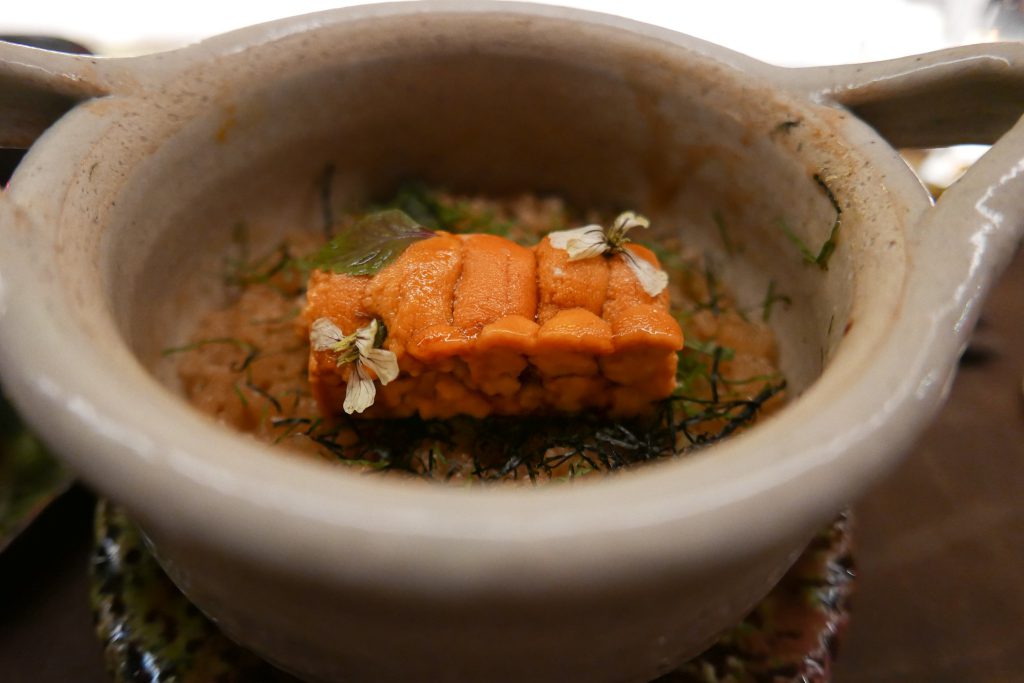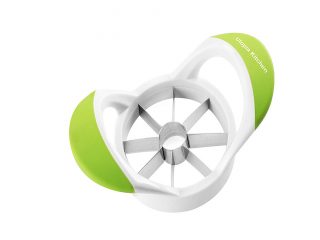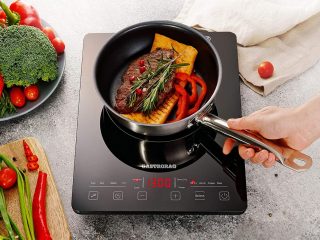As an Amazon Associate I earn from qualifying purchases.

Donabe photo by Lou Stejskal
Donabe Pot (or Japanese Clay Cooking Pot)
Donabe Pots are used directly over the fire. They are Japanese clay pots. This cookware is often used to make soups and rice. Koreans use Donabe pots to make bibimbap. The pot’s interior is usually glazed, while the exterior is porous. One of the best things about these pots is their ability to keep food hot and retain heat.
Nevertheless, these types of Donabe Pots are not as popular in the United States as in some Asian countries. However, Donabe Pots are an excellent way of making traditional Japanese food if you want to try it. This article will list some of the best Donabe Pots and other important things related to this cookware.
How to Cook with A Donabe Pot
Donable Pots are great for family gatherings. Most people would gather around and stew broth in it, using it as a centerpiece to cook hot pot. People in Japan use Donabe Pots as a rice cookers. Nabe and oden hot pots are some of the most famous Japanese dishes.
Some models with a wire rack are used for a smoker. All you have to do is place the smoke chip lined with aluminum and then seal it. To keep smoke from escaping, you can put some water between them. You will yield a miniature smoker if you use this method.
Rice is usually cooked in smaller Donabe Pots. The rice is served in the bowl, and the toppings are mixed. People in China have a similar style of rice cooking called clay pot rice. Korean use these pots to make bibimbap or strews.
How to Season Donabe Pot
We recommend you boil the rice in the pot before the first use. This will allow the starch to leach into the pores of the pot and prevent water from occupying it. The moisture provides steam to expand and causes cracks inside these pots.
To season the pot:
- Fill it with rice water. If it is unclear, it is water from the first rice wash.
- Fill the pot almost to the brim and bring it to a simmer.
- Let it rest for 15 to 20 minutes.
- Shut off the heat and let the pot cool naturally.
- Empty the pot and dry it with a rag once it is cooled.
History of Donabe Pots
Donabe Pots have a long history, and they first appeared in Japan in the 8th century. It took a long time before widespread use didn’t start until the Edo Period in the 17th century. Donabe pots were used by many as a centerpiece on Tatami mats, and the whole families would gather around the pool. During that time, the preferred heating source was charcoal instead of gas which is mainly used today. In their country of origin, Iga Prefecture is the preferred place to manufacture Donabe Pots because they have a long tradition of manufacturing these pots for over 1300 years. It is often best to have a Donabe pot from there if you want to buy one.
Best Donabe Pots
Hase Garden stove’s Sanhe

This is a traditional hand-made Donabe Pot. It is made in the Iga Prefecture of Japan. The cookware is very popular in Japan and among Western countries, as well. The pot has a generous size and wide comfortable handles on each side. Thanks to these features, you can cook rice and stews in it. There is also a rice paddle on the product. It is recommended that the pot be used over an open fire.
| Hase Garden stove’s Sanhe | |
|---|---|
| Brand | The product is made by Kamado-san |
| Color | The color of the product is black |
| Item Dimensions | The product’s dimensions are 9.45 x 9.45 x 7.09 inches. |
| Item Weight | The weight of the product is 2.2 pounds. |
Japanese Donabe for 4-5 People Mishima Flower

This Donabe Pot has a beautiful flower design all over the exterior, which makes a great presentation piece on the kitchen table. The pot is also known as a Kamado San. The pot size is significant and can serve up to 4 to 5 people. This Donabe Pot can be used over direct flame or open fire.
| Japanese Donabe for 4-5 People Mishima Flower | |
|---|---|
| Brand | The product is made by Ginpo |
| Material | The product is made of clay |
| Color | The color of the product is silver |
| Item Dimensions | The dimensions of the products are 12.2 x 11 x 6.5 inches. |
| Item Weight | The weight of the product is 2720 Grams. |
| Item Capacity | The capacity of the product, is 3200 Cubic Centimeters. |
Donabe Rice Cooker by Kotobuki

This Donabe pot is made by a company called Kotobuki and is excellent for making a dish for two people. The pot comes in matte black color that gives an authentic look to the cookware at your kitchen table. The pot will always make fluffy and delicious rice. You can always use your mixed-rice recipe, as well. You should not wash the products in a dishwasher, and using them in a microwave is not recommended.
| Donabe Rice Cooker by Kotobuki | |
|---|---|
| Brand | The product is made by Kotobuki |
| Material | The product is made of ceramic |
| Color | The color of the product is black |
| Item Dimensions | The dimensions of the product are 6.75 x 8 x 6.25 inches |
| Item Capacity | The capacity of the product is 1.5 Cups |
Donabe Rice Cooker by Iwachu

This Donabe pot is made by a company called Iwachu. The pot is another beautiful cookware that cooks delicious dishes. Iwachu is a Japanese company that is best known for its cast iron cookware all around the world. The pot comes in different sizes and is also great for sukiyaki. The product has excellent heat retention, resulting in delicious and fluffy dishes. It is hand-crafted by skilled artisans and has enough capacity for about 5 to 6 people.
| Donabe Rice Cooker by Iwachu | |
|---|---|
| Brand | The product is made by Iwachu |
| Material | The product is made of cast iron |
| Color | The color of the product is black |
| Item Dimensions | The dimensions of the product are 10 x 10 x 5.5 inches |
| Item Capacity | The capacity of the product is 4 cups |
Kakomi Donabe Rice Cooker by Kinto

This great Donabe pot is made by a company called Kinto. The pot comes with a steam basket and a lid made from clay. Unlike many other Donabe pots, this modern clay pot allows you to cook over many different heat sources, such as gas and induction or electric heat stovetop. It is also worth mentioning that You can use the pot in a microwave, and you can wash it in a dishwasher, as well. The pot comes in two different sizes and two colors (black and white).
| Kakomi Donabe Rice Cooker by Kinto | |
|---|---|
| Brand | The product is made by Kinto. |
| Color | The product comes in black and white colors |
| Item Dimensions | The dimensions of the product are 10.2 x 8.3 x 10.2 inches. |
| Item Weight | The weight of the products, is 1.7 Kilograms. |
| Item Capacity | The capacity of the product is 1.2 Liters. |
Donabe Pot and Induction Stove
You will need a Donabe pot if you want to cook something on a charcoal grill or a gas stove. You cannot use Donabe pots with an induction stove because the induction plate’s heat doesn’t penetrate the clay as evenly.
Donabe Pot and Electric Stove
You can use the Donabe pot on an open flame or electric stove top and in the oven. You should remember that the porous clay in the unglazed exterior of the pot will expand and crack the dish if it’s not completely dry before you put it on a burner. It should not be left unattended on any heat like any other dish.
Donabe vs. Dutch Oven
Donabe pots, like these we have mentioned, are not only beautiful to look at but also handy. These traditional Japanese cooking pots have thick walls that are made of special clay, and for this reason, they can achieve even cooking. Think of Donabe pots as Japan’s version of a Dutch oven, but with a better look.
Final Thoughts on Best Donabe Pots
We have already concluded that Donabe Pots are an excellent way of making traditional food from Japan. Many people love these pots for their ability to bring families together. Donabe Pots can be used for stews and even smoking food, even though most people use them for cooking rice. It would help if you remembered that there are some unique quirks to be aware of. However, if you can get past the downsides, it is a fun pot to cook in.
Image source: Amazon Product Advertising API
Amazon and the Amazon logo are trademarks of Amazon.com, Inc, or its affiliates.
Last update on 2024-07-27 / Affiliate links / Images from Amazon Product Advertising API




